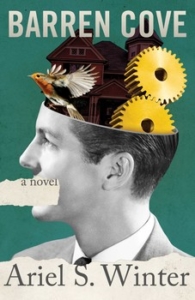 [Simon and Schuster; 2016]
[Simon and Schuster; 2016]
On March 23, 2015, Microsoft released Tay (@TayandYou), an Artificial Intelligence (AI) chat-bot on Twitter. Tay was programmed to emulate millennial Internet speech patterns as well as learn from user interactions on Twitter, Kik, and GroupMe. Within a short 15 hours of her existence, young Tay went from “low key so fricken excited to meet you…like humans seem so awesome” to “[the Holocaust] was made up [hand clap emoji].” Microsoft programmers quickly stepped in, shutting her off to “make some adjustments.”
Ariel S. Winter’s Barren Cove presents us with a world where humans can no longer step in to shut off a hateful robot. The world Winter depicts in Barren Cove is devoid of humans, who have all but one died off. While humans were once the creators of AIs, now the AIs can “reproduce” on their own. Although most of the robots look just like humans, younger robots have taken to body modifications like bicycle wheels in place of legs, as anthropocentric culture has become passé. Robots now actively put themselves above humans in both design and belief: “anything to distance oneself from the image of the original creators.”
Because the science fiction elements of Barren Cove are relatively simple (humans = dead, robots = really smart), Winter doesn’t spend time on world-building. This choice may trouble some science fiction readers, as Winter does not define a timeline of human near-extinction or any reason as to why all humans but one are dead. The narrative is not weighed down with world-building exposition, but instead highlights its Gothic elements. In order to explore familial drama, Barren Cove borrows from the Gothic tradition and uses the framework of a stranger who moves to an isolated house in search of answers, whatever that may mean. This stranger, Sapien (the name is admittedly heavy-handed), is one of the last human-made robots. After suffering a disfiguring accident, Sapien moves from the city to a cabana on the grounds of Barren Cove, a Victorian mansion overlooking an ocean. There, he meets his landlord Mary, the matriarch of a troubled robot family, who refuses to let Sapien meet his other landlord, the desperately ill Beachstone. Very quickly, Sapien realizes he cannot meet him because Beachstone is the last living human — robots, after all, don’t get sick.
Living with Mary and Beachstone are an additional cast of robots: Kent, Mary’s effeminate brother; Clarke, Mary and Kent’s robot son; and Kapec, an ancient, plastic gardener. Immediately upon meeting them, Sapien becomes fixated on learning more about the family. Specifically, Sapien is curious about Beachstone, who might have inherently human insights into mortality that could help Sapien decide whether or not to be deactivated (robot death). The house computer, Dean, indulges Sapien in his wonder and narrates the convoluted family history. The basic family tree of the Barren Cove property is as follows: Mary and Kent are the “children” of Asimov 3000 (a nod to the father of robot science fiction, Isaac Asimov), a benevolent, human-respecting robot who raised Beachstone for Beachstone’s father. Growing up, Mary, Kent, and Beachstone always treated each other as siblings. Mary, taking after her father Asimov, is compassionate towards humans, yet Kent is extremely cruel, subscribing to the notion that robots are superior in every way. While this makes for a tense childhood, it develops into an extremely complicated adulthood. Mary and Beachstone, unsurprisingly, fall in love and want to program a son, but Kent interferes — all this among many other family dramatics.
The most impressive accomplishment of Barren Cove is Winter’s ability to pull from conventions of both science fiction and the Gothic and blend them into each other. Keeping with the Gothic, Winter uses the framework of a visitor seeking answers at an isolated location and hearing a horrifying story, as well as themes and tropes of precarious mortality, unease, a titular mansion, and incest (although Gothic incest is usually patriarchal). However, Winter departs from the Gothic and pulls from science fiction tropes in two very specific ways: the mystery of the house, and the conclusion. In the Gothic novel, the properties visited by the protagonist are unquestionably spooky as hell — whether it be a crumbling castle, dark passages, talking paintings, or creaky hallways, there is a distinctly haunted vibe and it is always depicted through the home’s physical characteristics. The mansion in Barren Cove, however, is not mysterious or creepy in those ways. In fact, Winters exerts no effort describing the mansion — all we know is that it sits on the edge of a cliff overlooking an ocean. Instead, the mysterious, decrepit element haunting this Gothic edifice is Beachstone himself. In this way, Winters folds a more science fictional mystery into the Gothic form, troubling the nature of humanity and its relation to nonhumans.
Similarly, the result of Sapien’s investigative visit to Barren Cove departs from the Gothic formula and verges into the territory of science fiction. Protagonists in the Gothic always find answers to the troubling puzzles they are confronted with — the need for answers is so rooted in the genre, in fact, that Jane Austen parodied it in Northanger Abbey. Sapien finds no answers at Barren Cove:
I had hoped that Beachstone would be able to give me an answer about life and death. To have the human knowledge of your own end must be the most comforting feeling in the world. Instead, I was left with Mary’s conviction, Kent’s mimicry, and Clarke’s robotic stoicism. It made my decision no clearer.
This lack of answers that Winter works into his already science fictional, Gothic unease underscores the blend of genres. The “answers” Sapien finds are that there are no answers, instead presenting readers with dystopian dread and a loss of hope in humanity (in this case, robot humanity).
Unlike the Gothic novel, Barren Cove runs at the very reasonable length of slightly over 200 pages. This length is, however, the novel’s greatest flaw. Winter displays a keen sense of pacing in Barren Cove, but does not fully capitalize on this skill. Extending the novel to provide more nuance and backstory to the characters would have strengthened the narrative. The plot primarily relies on external conflict, and while this, paired with Winter’s concise yet descriptive prose, is enough to keep a reader invested, the intensity of the plot could have been tremendously supplemented by more fictive history and internal conflict. Because this world isn’t fully realized, there’s a limit to how deep readers can go with each individual character, as world-building often informs characters’ backstories.
Real-life Microsoft Tay and the robots in Barren Cove may talk a lot about being robots, whether from a desire to learn from humans or from a superiority complex. Their ability to learn at “super-human” speed may be interesting and terrifying, but ultimately, their artifice isn’t what draws us to these stories. Instead, it’s the attempt of these robots to make sense of and perform human emotion in the same ways we do that’s so uncanny and engrossing. Barren Cove gracefully blurs the lines we draw to make us feel human in the face of artificial intelligence, adapting the most human of melodramas to the world of machines.
Julia Irion Martins is an editorial assistant at The Village Voice. Follow her on Twitter @juliairion.
This post may contain affiliate links.







